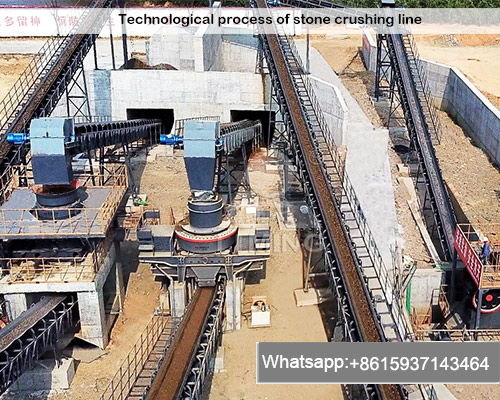Technological process of stone crushing line
Stone crushing is a crucial process in the construction industry, transforming large, irregular rocks into usable aggregates for various applications. The technological process of a stone crushing line involves a series of mechanical operations that progressively reduce the size of the stones to achieve the desired particle size and shape.

1. Feeding and Initial Crushing:
The process begins with feeding the raw stones into the crushing line, typically via a hopper or conveyor belt. The first stage of crushing is usually carried out by a jaw crusher, which utilizes two opposing jaws to break down the stones into smaller pieces. The size of the initial crushed material depends on the specific requirements of the downstream processes.
2. Secondary and Tertiary Crushing:
After primary crushing, the partially broken stones are transported to a secondary crusher, often an impact crusher or cone crusher. These crushers further reduce the particle size, typically to a range of several centimeters. In some cases, a tertiary crushing stage may be employed to achieve even finer particle sizes.
3. Screening and Classification:
Once the stones have reached the desired size range, they are passed through a series of vibrating screens. These screens separate the crushed material into different particle sizes based on their dimensions. The graded aggregates are then collected and stored in separate bins or stockpiles for further processing or use.
4. Sand Making (Optional):
If the final product requires sand-sized particles, a sand making machine may be incorporated into the crushing line. This machine utilizes various techniques, such as impact or grinding, to further reduce the crushed material to produce sand particles.
5. Dust Collection and Environmental Control:
The stone crushing process generates dust particles, which can pose health and environmental hazards. To mitigate this, dust collection systems are integrated into the crushing line. These systems capture dust particles and release clean air back into the atmosphere.
6. Conveying and Transportation:
Throughout the crushing line, conveyor belts are used to transport the material between different stages of processing. These belts ensure a continuous and efficient flow of material throughout the plant.
7. Control and Automation:
Modern stone crushing lines are equipped with sophisticated control systems that monitor and regulate the various processes. These systems ensure optimal performance, minimize downtime, and enhance overall safety.
The technological process of a stone crushing line is a complex and multifaceted operation that involves a combination of mechanical, electrical, and control systems. By employing efficient and innovative techniques, stone crushing plants can produce high-quality aggregates for a wide range of construction and industrial applications.








